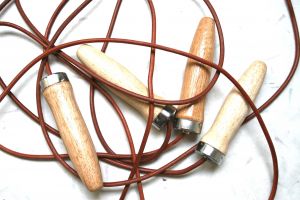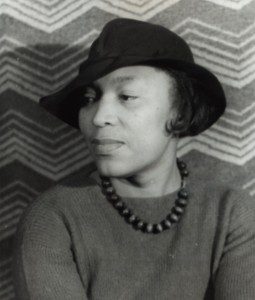
The arc of the ropes was mesmerizing, as was the rhythmic one-two, one-two as they hit the ground. I had jumped Double Dutch before and always managed to skip the responsibility of turning. But, at some point, I would have to take the ropes and I was afraid of being exposed as “double-handed,” unable to turn the ropes correctly and keep them aligned.
Such a failure would end my dream of competing in Double Dutch tournaments. The fantasy of the latter was second to the hope of social acceptance. You see, my fellow playmates had already branded me as “acting like a white girl,” and everyone knew that white girls were double handed, as demonstrated by their general absence at tournaments and in the McDonald’s television commercials. White girls didn’t jump Double Dutch, much less turn the rope. This was a black girl’s domain: enjoyed and governed only by us.
On the afternoon when I finally took the ropes, my arc was shaky at best. I turned for exactly for eight beats when a girl, whose name I can’t remember, smoothly took the ropes from me and then turned with a vigor that made the on-two tap even quicker for the jumper.
“Oh, she’s double-handed,” the jumping girl said. “I knew it.” It was akin to the Sandman tap-dancing to abort a stinker of a performance at the Apollo Theater. I was done.
The first few times I was told I “acted white” I was terribly confused. A dark-skinned girl, no one could ever mistake me for being other than black; I knew I was black and had no idea how I could act otherwise. When I tried to act differently (dropping a few g’s, placing hands on hips), I was rightfully taken to task for being inauthentic by my family and friends. What made the accusation of “acting white” doubly confusing and absurd was that prior to the Double Dutch verdict, I had endured my share of racial epithets in both my New York city elementary school and in the rural Pennsylvania town where my family owned a country home.
“So you’re really black?” a white boy asked me one summer in the tortuous day camp where I repeatedly told the teenaged counselors of the racist epithets my brother and I endured. The teenagers just tossed their Sun-In summer streaked hair and looked away. “I can’t stop them,” said the only one willing to respond.
“No matter how hard you scrub, you can’t take it off?” the boy persisted.
In the post-Civil Rights dawn, when it became clear to me that all racism and discrimination was not going to stop or be stopped, I needed backup. I found it in books. I read widely and built a posse that included James Baldwin, Ralph Ellison, Maya Angelou, Richard Wright, Audre Lorde, Toni Morrison, and Alice Walker; eventually Frantz Fanon, W.E.B. DuBois, and Jamaica Kincaid joined in. My posse helped me to understand race and class and how we were all subjected to the same racial prejudice though it may have been meted out in different ways. I did not wish to be complicit; as Frantz Fanon wrote: “Because of its struggle to gain acceptance by whites, the black bourgeoisie has failed to play the role of a responsible elite in the Negro community.”
I embraced writers both black and not, but when I wrote a passionate paper on John Steinbeck my 11th-grade teacher falsely accused me of plagiarism. When I protested the low grade, he only suggested that my future papers be less expressive. Like Césaire I longed to proclaim: “Take me as I am. I don’t adapt to you!”
Auditing a college art history class while a high school senior, I overheard students telling jokes and laughing at the breasts of topless West African women as depicted in sculpture and photography. I started to lecture them but was already exhausted by the prospect of being accused of militancy. The experience sealed my decision to attend Howard University.
 Stepping onto the yard at Howard, I threw my arms wide like Julie Andrews in the Sound of Music. I twirled around. Love me! Black Me! My green army jacket replete with handsewn red, black, and green ribbons billowed around me. Then, the day before classes started, I was informed by a junior that I talked “like a white girl.” My inner Julie Andrews abruptly stopped twirling.
Stepping onto the yard at Howard, I threw my arms wide like Julie Andrews in the Sound of Music. I twirled around. Love me! Black Me! My green army jacket replete with handsewn red, black, and green ribbons billowed around me. Then, the day before classes started, I was informed by a junior that I talked “like a white girl.” My inner Julie Andrews abruptly stopped twirling.
“How can you say that I talk like white girl? I asked. “I’m here.”
“You’re here, talking like a white girl.”
Fortunately those kinds of conversations were rare. Over the next four years I found friends with a myriad of interests, ways of being and speaking that did not fall squarely into some narrow definition of “blackness.” I would meet black folks from all over the country and all over the world.
In a creative writing class, a friend and I noticed that the professor gave higher marks to work that was obviously focused on race and explicitly angry. Our writing which didn’t follow that vein earned us lower grades. To test our observation, we agreed to submit writing that fed into every possible stereotype: I penned a free-verse poem that lamented the plight of black womanhood (badly using a head scarf as a metaphor). My classmate submitted an unforgettable poem which began: “Cockroach on my kufi, crawlin’, crawlin’/Crawlin’ all over like the man. /Cockroach, are you the man?” We each earned an “A.”
One could argue that black people sometimes criticize or limit each other for not being black enough largely because of the dearth of more diverse images of the black experience in film, television, and books. During my long career as a book club editor and one of the few black people in publishing, I actively promoted books by black, Latino/a, Asian, and LGBT authors.
 Was I surprised when during a group water cooler chat a white colleague asked me alone if I had been to college? No. Was I surprised when one of the two other black employees told me she didn’t think I liked black men? No. And when I assured her I did (just not romantically, as I am a lesbian), was I not “black enough” all over again? No, not really, but I was tired.
Was I surprised when during a group water cooler chat a white colleague asked me alone if I had been to college? No. Was I surprised when one of the two other black employees told me she didn’t think I liked black men? No. And when I assured her I did (just not romantically, as I am a lesbian), was I not “black enough” all over again? No, not really, but I was tired.
I took solace in Zora Neale Hurston:
I am not tragically colored. There is no great sorrow dammed up in my soul, nor lurking behind my eyes. I do not mind at all. I do not belong to the sobbing school of Negrohood who hold that nature somehow has given them a lowdown dirty deal and whose feelings are all hurt about it. . . . I have seen that the world is to the strong regardless of a little pigmentation more or less. No, I do not weep at the world — I am too busy sharpening my oyster knife.
Here are some of the things I’ve heard in relationship to my “blackness:”
Oreo.
You’re black, but you’re not “black black”.
Nigger.
Why do you always talk about that [race]?
You talk/ act like a white girl.
I don’t think of you as black.
Why are you so angry?
I was black. I wasn’t black enough. I was too black. Sometimes I was so upset there was nothing to do but sit down and eat a pack of Oreos—alone, of course. But for years I wouldn’t feel comfortable eating the crème-filled sandwich cooking without pausing for the fleeting impulse to turn and see if anyone was looking. Oh look, an Oreo eating an Oreo! (It’s still not my cookie of choice). I was being pigeonholed; and as Jessye Norman said, pigeonholing is interesting only for pigeons.
At times Blackness is a slippery definition married to ancestry but extending beyond any one drop rule; born without and defined within and without. Black is a label ascribed to black folks from outsiders and within that label we have defined ourselves, our cultures and our very being. The fixed and enduring nature of the negative external definition of black, and its legacies make it tempting to internally make the definitions similarly inflexible. Or linked to class and a narrow set of experiences. In Volunteer Slavery, Jill Nelson writes about the ping-ponging experience between white racism and definitions of blackness. “I was looking for the authentic Negro experience,” she writes “which of course my own wasn’t, since being bourgeois somehow negated being black.”
In a post-racial society would a narrow definition of acting black be obsolete? Well, there is no such thing as post-racial as many have pointed out, but a twin fact is that some of the narrow notions of what being black and acting black endures (do an internet search for “act like white girl” and see what comes up). Just as black men and women are assumed to be scamming when purchasing luxury goods at Barney’s, and stopped and frisked or murdered when assumed to be robbing houses when they are innocently trying to make their way home, there is often an assumption of an acceptable way of being black among black folks themselves.
In his memoir Colored People, Henry Louis Gates, Jr. writes:
I rebel at the notion that I can’t be part of other groups, that I can’t construct identities through elective affinity, that race must be the most important thing about me. Is that what I want on my gravestone: Here lies an African American? So I’m divided. I want to be black, to know black, to luxuriate in whatever I might be calling blackness at any particular time — but to do so in order to come out the other side, to experience a humanity that is neither colorless nor reducible to color. Bach and James Brown. Sushi and fried catfish.
I rebel too. I love sushi, but fried catfish, not so much. I love Bossa Nova and in a few weeks a close (and also black) friend and I will be seeing Michael McDonald at the Apollo. Really, it’s too long an explanation and one that exists in the unique DNA–physical and emotional– in every human being. To quote James Baldwin: “Identity would seem to be the garment with which one covers the nakedness of the self; in which case, it is best that the garment be loose.”
***




